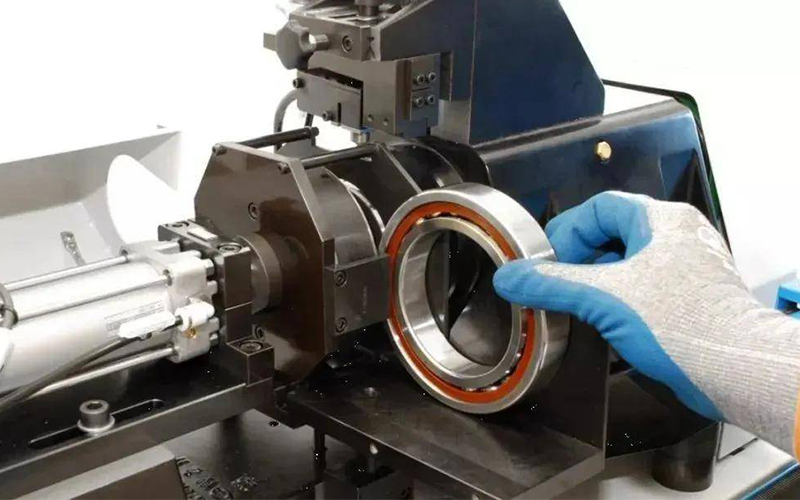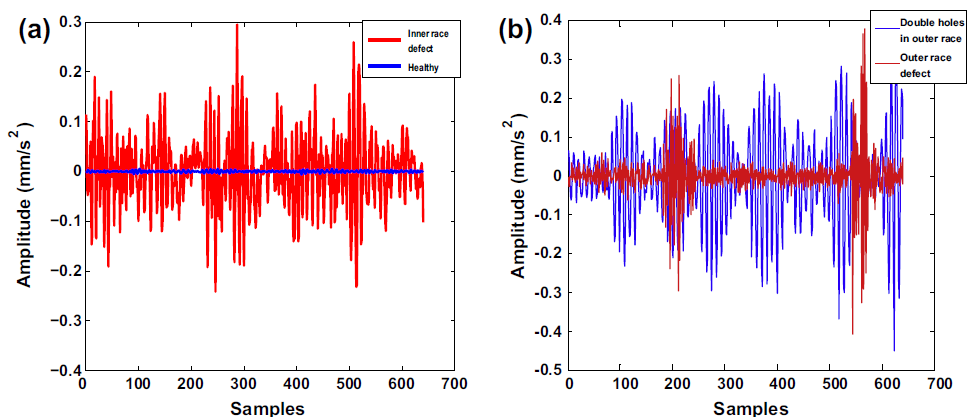Wishlist
The products are limited
The products are limited
Bearings, as one of the key components of mechanical equipment, their normal operation is critical to the performance and life of the equipment. However, when abnormal sounds occur in bearings, it often signals potential problems and failures. In this essay, we will discuss in depth the causes, effects and coping strategies of abnormal bearing sounds.

A bearing is a mechanical element that limits relative motion to a desired range of motion and reduces friction between moving parts.
It usually consists of an outer ring, an inner ring, an olling element, and a cage.
Its main function is to support the mechanical rotating body, reduce the friction coefficient during its movement, and ensure its rotation accuracy.
Bearings can be broadly categorized in different ways according to the type of operation, permissible motion, or the direction of the load (force) applied to the part.
High-precision Angular contact ball bearings | |
| It can withstand both radial and axial loads. They can work at higher speeds. The larger the contact angle degree, the higher the axial load-carrying capacity. The contact angle for the radial plane ball and raceway contact point line and bearing axis of the vertical line between the angle. High speed and high precision and bearings usually take 15 15-degree contact angles. Under the action of axial force, the contact angle will be increased. |
Inch/Metric size Miniature bearings | |
| Miniature bearings refer to metric series, the outer diameter is less than 9mm; inch series, the outer diameter is less than 9.525mm of various types of bearings! The main materials are bearing steel, stainless steel, plastics, ceramics, etc., of which the smallest inner diameter can be 0.6mm and the general inner diameter of 1mm. |
Deep groove ball bearings | |
| Deep groove ball bearings are the widest range of rolling bearing types. Characterized by high speed and small frictional resistance, it can be used to withstand radial load or radial and axial at the same time. The role of the joint load on the machine can also be used to withstand the axial load on the machine, such as low-power motors, automobiles and tractors gearboxes, machine tool gearboxes, general machines, tools, etc. |
Spherical roller bearings | |
| Spherical roller bearings have double rows of rollers. The inner ring has two raceways and is tilted to an angle relative to the bearing axis, and the outer ring has a common spherical raceway. This clever structure makes it have automatic centering performance, thus not easily affected by the shaft and bearing housing angle to error or shaft bending. They are suitable for installation errors or shaft deflection caused by the angular error of the occasion. The bearings can withstand radial load but also can withstand two-way action of the axial load. |
Cylindrical roller bearings | |
| Cylindrical roller bearings are centripetal rolling bearings with cylindrical rollers. Cylindrical roller bearings' internal structure adopts the rollers arranged in parallel between the rollers are equipped with a spacing keeper or isolation block, which can prevent the roller from tilting or roller friction between each other, effectively avoiding the increase of rotating torque. |
Spherical roller thrust bearings | |
| The spherical roller bearings and the thrust spherical roller bearings are almost the same: seat ring raceway surface with the bearing center axis of the same point as the center of the sphere, the bearing roller for the spherical type, therefore, with automatic centering function, the coaxial and shaft deflection is not very sensitive. |
Taper roller bearings | |
| Tapered roller bearings belong to the separation of bearings; bearings of the inner and outer rings have tapered raceways. This kind of bearings, according to the number of rollers installed, is divided into four rows, single row and double row of tapered roller bearings and another different structure type. |
Cross roller bearings | |
| Cross roller bearings are a kind of inner ring divided, outer ring rotating special type bearings, because of their special structure, in the industrial robot, are usually used as joint bearings.Tapered roller bearings belong to the separation of bearings; bearings of the inner and outer rings have tapered raceways. This kind of bearings, according to the number of rollers installed, is divided into four rows, single row and double row of tapered roller bearings and another different structure type. |
Needle roller bearings | |
| Needle roller bearings are roller bearings with cylindrical rollers, which are long and thin relative to their diameter. These rollers are called needle rollers. Despite the small cross-section, the bearings still have a high load-carrying capacity. Needle roller bearings are equipped with long and thin rollers (roller diameter D ≤ 5 mm, L / D ≥ 2.5, L is the length of the roller), so their radial structure the compact. When the load capacity and the size of the inner diameter are the same as other types of bearings, they have the smallest outside diameter, so especially for radial mounting, the dimensions of the support structure are limited. |
Abnormal Noise: There may be abnormal sounds such as sharp hissing, friction, buzzing or metal collision.
high-frequency noise: there may be a higher frequency of noise.
Irregular sound: the sound may be unstable, irregular, large and small or intermittent noise.
Increased noise: As the condition of the bearing deteriorates, the noise may gradually increase.
The sound of normal running bearings is usually smooth, even and low.
Its sound will generally remain continuous and stable; there will be no obvious terminal or sudden change; its volume is relatively small and will not produce too harsh or strong a sound; general bearing in normal operation sounds with a certain rhythm and regularity, there will be no irregular changes, and it will sound smooth, no jamming or friction feeling.

Damaged bearings may result in increased clearance and abnormal friction sounds during operation;
If the amount of lubricant used in the bearing is too small or the quality of the lubricant is not good, abnormal friction sounds will also be produced during operation;
If the bearing is damaged, such as cracked, spalled, etc., it will lead to irregular vibration and sound when running;
When foreign matter enters inside the bearing, the foreign matter will hinder the normal operation of the bearing and cause the bearing to produce abnormal noise;
When installing bearings, if they are improperly assembled, they may also cause the internal force to be uneven, resulting in abnormal sounds;
If, in the process of operation, the force exceeds the bearing capacity of the bearing, causing missing deformation or wear, it will also lead to abnormal sound of the bearing;
Bearing material will also affect the sound of the bearing; if the bearing material is not hard enough, poor toughness, the bearing is prone to failure and produces a strange sound.
If the bearing runs for a long time, fatigue cracks may also occur, resulting in abnormal sound.
The combined effect of these factors, yes, bad bearings, makes strange sounds when running, which is an important indication of bearing failure, reminding people to carry out timely overhauls and maintenance.

Neglecting bad bearings will affect the normal operation of the equipment and reduce the working efficiency;
If the bad bearing is not overhauled and replaced for a long time, it may cause other parts to be subjected to additional load and wear, accelerating the overall damage to the equipment;
It may also lead to equipment failure, increasing safety risks, and will shorten the service life of the equipment and increasing the frequency of equipment replacement;
In the event of increased equipment failure, maintenance costs will increase accordingly, and production schedules will also be affected, resulting in financial losses;
In order to avoid these consequences, the state of the bearings should be checked regularly, and bad bearings should be found and replaced in time to ensure the normal operation and long-term stability of the equipment.

Currently, there are two ways to detect abnormal bearing sounds. One is based on the acoustic noise detection method; the other is based on the vibration detection method.
Is in the base noise is less than 20db muffled environment, the use of a high-quality microphone to a certain distance and direction to extract the bearing sound pressure signal, and after a certain analysis method to extract the abnormal sound components, is the direct measurement method of abnormal sound.
It is an indirect detection method of abnormal sound, which can be divided into qualitative detection methods and quantitative parameter detection methods. Among them, the qualitative detection method is divided into listening to the abnormal sound method and observing the vibration waveform method. The quantitative parameter detection method refers to the measured bearing vibration signal with abnormal sound-related measured parameter values such as vibration peak and crest factor to evaluate the abnormal sound of the bearing.

The material of the bearing is very important for its service life and reliability. Generally speaking, choosing wear-resistant, high-strength, oxidation-resistant materials can improve the service life and reliability of bearings. For example, bronze, carbon steel, high carbon alloy steel and other materials are commonly used bearing materials.
Correct installation methods are very important for the service life and reliability of bearings. When installing, you need to pay attention to the position of the bearing, the machining accuracy of the shoulder, the concentricity of the shaft and other factors. The position of the bearing should be as symmetrical as possible to avoid stress concentration. The machining accuracy of the shaft shoulder should be as high as possible to ensure the stability and reliability of the bearing. The concentricity of the shaft should be kept as small as possible to avoid bearing wear and damage.
Lubricant is also very important for the service life and reliability of bearings. Choosing the right lubricant can improve the lubrication effect of the bearing and reduce wear and damage. Commonly used lubricants include solid lubricants, liquid lubricants, gas lubricants and so on. Choosing the right lubricant can improve the lubrication effect and reduce wear and damage.
Regular inspection and maintenance are very important to prevent bearing failure. Inspection needs to check the running status of bearings, timely detection of abnormalities, and deal with them. Suppose the bearings are found to have abnormal noise, high temperature, abnormal wear and tear, etc. In that case, it is necessary to deal with the situation in a timely manner to avoid the expansion of the failure.
Keep clean: regularly clean the bearings and the surrounding environment to prevent dust and impurities from entering.
Correct installation: ensure that the bearings are installed correctly; avoid skewed, too tight or too loose.
Reasonable lubrication: choose the right lubricant and lubricate it according to the specified time and method.
Regular inspection: check the running condition of the bearings regularly, find the abnormality in time and deal with it.
Avoid overloading: avoid bearings to bear excessive load.
Control temperature: prevent the bearings from working under too high or too low-temperature environments.
Proper storage: when not in use, bearings should be properly stored to avoid moisture and corrosion.
Conclusion
This article focuses on the problems related to abnormal bearing sounds. The article describes the causes of abnormal bearing sound, such as wear, poor lubrication, improper installation and so on. Meanwhile, the characteristics of abnormal sounds, such as friction sounds, knocking sounds, etc., are described in detail. The importance of timely detection and diagnosis of abnormal bearing sounds is also emphasized to avoid the expansion of faults and equipment damage. In addition, the article puts forward some countermeasures and maintenance suggestions to ensure normal operation and prolong the service life of bearings.
Please contact us at https://www.tfl-bearing.com/contact for any questions about bearings, and if you are choosing a ball bearing distributor, we would be happy to give you a quote.